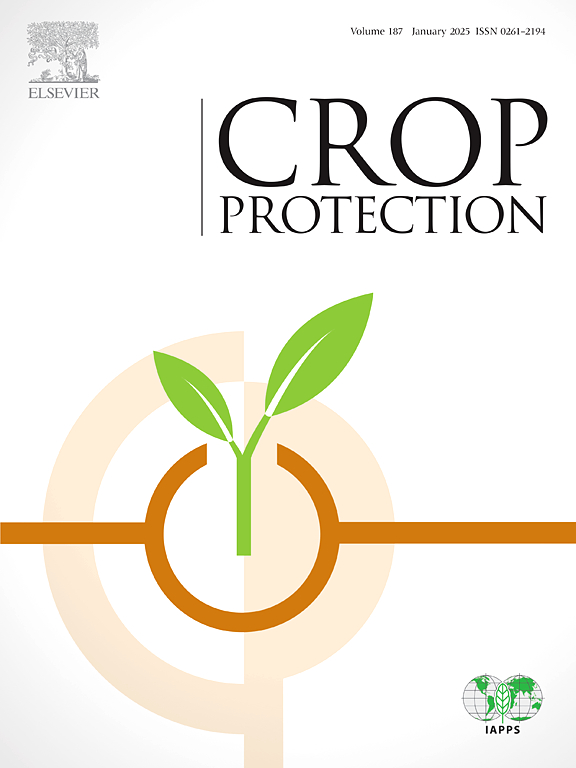Susceptibility monitoring and metabolic resistance study of Echinochloa crus-galli to three common herbicides in rice regions of the Mid-Lower Yangtze, China
IF 2.5
2区 农林科学
Q1 AGRONOMY
引用次数: 0
Abstract
Echinochloa crus-galli, a dominant weed in rice fields, has developed increasing herbicide resistance, complicating its control. This study evaluated the susceptibility of 30 E. crus-galli field populations to three commonly used herbicides: metamifop (ACCase inhibitor), penoxsulam (ALS inhibitor), and quinclorac (auxin herbicide). Resistance ratio (RI) ranged from 1.1- to 7.9-fold for metamifop, 1.1- to 27.9-fold for penoxsulam, and 1.3- to 55.9-fold for quinclorac. A gradual decline in herbicide efficacy was observed, with an increasing number of multi-resistant populations over time. Multi-resistant populations (CB18, CB19, CB20, JL20, NX20) exhibited significantly higher P450 and GST enzyme activities compared to susceptible populations (S0). Furthermore, genes involved in metabolic resistance, including CYP81A12, CYP81A14, CYP81A21, CYP81A68, and GSTU23, were significantly upregulated in multi-resistant populations. This study provides insights into the resistance dynamics of E. crus-galli in the Mid-Lower Yangtze rice region, contributing valuable data for improving herbicide management strategies and resistance mitigation.

长江中下游水稻区棘球藻对3种常用除草剂的敏感性监测及代谢抗性研究
紫锥藻(Echinochloa cros-galli)是稻田中的主要杂草,其抗除草剂性日益增强,使其防治复杂化。本研究评估了30个十字花科油菜田间群体对三种常用除草剂的敏感性:甲氨磷(ACCase抑制剂)、培诺舒南(ALS抑制剂)和喹洛酸(生长素除草剂)。耐药比(RI)范围为:metamifop为1.1- 7.9倍,penoxsulam为1.1- 27.9倍,quinclorac为1.3- 55.9倍。随着时间的推移,多重抗性种群数量的增加,除草剂的药效逐渐下降。多抗性群体(CB18、CB19、CB20、JL20、NX20)的P450和GST酶活性显著高于易感群体(S0)。此外,参与代谢抗性的基因,包括CYP81A12、CYP81A14、CYP81A21、CYP81A68和GSTU23,在多重抗性群体中显著上调。本研究揭示了长江中下游水稻区十字花菜的抗性动态,为改进除草剂管理策略和缓解抗性提供了有价值的数据。
本文章由计算机程序翻译,如有差异,请以英文原文为准。
求助全文
约1分钟内获得全文
求助全文
来源期刊

Crop Protection
农林科学-农艺学
CiteScore
6.10
自引率
3.60%
发文量
200
审稿时长
29 days
期刊介绍:
The Editors of Crop Protection especially welcome papers describing an interdisciplinary approach showing how different control strategies can be integrated into practical pest management programs, covering high and low input agricultural systems worldwide. Crop Protection particularly emphasizes the practical aspects of control in the field and for protected crops, and includes work which may lead in the near future to more effective control. The journal does not duplicate the many existing excellent biological science journals, which deal mainly with the more fundamental aspects of plant pathology, applied zoology and weed science. Crop Protection covers all practical aspects of pest, disease and weed control, including the following topics:
-Abiotic damage-
Agronomic control methods-
Assessment of pest and disease damage-
Molecular methods for the detection and assessment of pests and diseases-
Biological control-
Biorational pesticides-
Control of animal pests of world crops-
Control of diseases of crop plants caused by microorganisms-
Control of weeds and integrated management-
Economic considerations-
Effects of plant growth regulators-
Environmental benefits of reduced pesticide use-
Environmental effects of pesticides-
Epidemiology of pests and diseases in relation to control-
GM Crops, and genetic engineering applications-
Importance and control of postharvest crop losses-
Integrated control-
Interrelationships and compatibility among different control strategies-
Invasive species as they relate to implications for crop protection-
Pesticide application methods-
Pest management-
Phytobiomes for pest and disease control-
Resistance management-
Sampling and monitoring schemes for diseases, nematodes, pests and weeds.
 求助内容:
求助内容: 应助结果提醒方式:
应助结果提醒方式:


